Assyria in earliest historical times referred to a region on the Upper Tigris river, named for its original capital, the ancient city of Ashur. Later, as a nation and Empire, it also came to include roughly the northern half of Mesopotamia (the southern half being Babylonia). Assyria proper was located in a mountainous region, extending along the Tigris as far as the high Gordiaean or Carduchian mountain range of Armenia, sometimes called the "Mountains of Ashur".
Of the early history of the kingdom of Assyria, little is positively known. According to some Judeo-Christian traditions, the city of Ashur was founded by Ashur the son of Shem, who was deified by later generations as the city's patron god. Besides Ashur, the other three royal Assyrian cities were Calah (Nimrud), Khorsabad, and Nineveh.
This region seems to have been ruled from Sumer, Akkad, and northern Babylonia in its earliest stages, being part of Sargon the Great's empire. Destroyed by barbarians in the Gutian period, it was rebuilt, and ended up being governed as part of the Empire of the 3rd dynasty of Ur. Assyria as an independent kingdom was perhaps founded ca. 1900 BC by Bel-kap-kapu.
Basic to the central region of Assyria was farming, fed by both the Tigris river and water from the Armenian mountains in the north, and the Zagros mountains in the east. With the expansion of Assyria, more land brought other economies, like mining and forestry. It is believed that Assyria's civilization resulted from the immigration of an unknown people into the area around 6000 BCE. This was followed by Semitic immigration about 3 millenia later. Life was confined to small villages, and there was an intricate system of irrigation that fed the agriculture. There were few larger cities, and these served as trade and craft centres. Assyria had some slaves, but these played only a small part in the economy.
Assyrian architecture used mud bricks, and occasionally stone. Houses and buildings never exceeded one storey and had flat roofs. While most houses were modest, palaces and temples could cover large areas inside the cities.
Sculptures and wall carvings were another central part of Assyrian culture, and showed high skill in craftsmanship.
Document cylinder seals became an art form in itself, as intricate patterns and shapes were given to these.
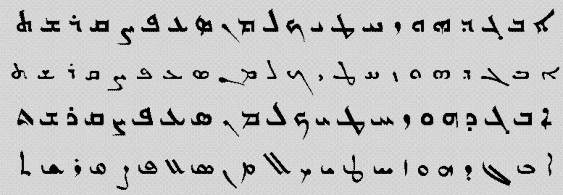
Assyrians have used two languages throughout their history: ancient Assyrian (Akkadian), and Modern Assyrian (neo-syriac). The Arameans, would eventually see their language, Aramaic, supplant Ancient Assyrian because of the technological breakthrough in writing. Aramaic was made the second official language of the Assyrian empire in 752 B.C. Although Assyrians switched to Aramaic, it was not wholesale transplantation. The brand of Aramaic that Assyrians spoke was, and is, heavily infused with Akkadian words, so much so that scholars refer to it as Assyrian Aramaic.
Among the finest cultural achievements of Assyria was literature, which initially used a cuneiform alphabet from the Babylonians written on clay tablets until 750 BC. Later an Aramaic script written on parchment, papyrus, or leather predominated. The literature dealt with a number of subjects like legal issues, medicine and history.
The Assyrian culture had dramatic growth in science and mathematics. This can be in part explained by the Assyrian obsession with war and invasion. Among the great mathematical inventions of the Assyrians were the division of the circle into 360 degrees and were among the first to invent longitude and latitude in geographical navigation. They also developed a sophisticated medical science which greatly influenced medical science as far away as Greece.
There is ongoing discussion among academics over the nature of the Nimrud lens, a piece of rock crystal unearthed by John Layard in 1850, in the Nimrud palace complex in northern Iraq. A small minority believe that it is evidence for the existence of ancient Assyrian telescopes, which could explain the great accuracy of Assyrian astronomy.
Older Gods
- Anu is a supreme god of the Sumerian pantheon and shares the title 'king of heaven and earth with Enlil. He is in mythology a somewhat dim personality. He doesn't figure very often in epics and even when he does, he has little specifics in his character, apart from possibly a `fatherly attitude'. Anum is the head of the divine dynasty, but he leaves the exercise of sovereign authority to Enlil. Only in times of crisis (e.g. when the gods are on strike, see the Atrahasis epic) it is Anum himself who presides the general assembly of the gods.
Anu is at home in Uruk, together with the (city) goddess Itar. In a late first millenium composition, called `the exaltation of Itar, it is described how she obtaines the status of Antum, the spouse of Anu. In the epilogue of the Codex Hammurabi he is called Anum rabu. The great Anum, father (ancestor) of the gods' In the Creation Epic Enuma eli it is told how Anu transfers his power to Marduk (city god of Babylon), who gradually becomes the new supreme god in the blooming days of the city Babylon. In the Seleucid era (331 - 125 BCE) Anu is identified with the Greek supreme god Zeus. (After the Old Babylonian period the final -m in case endings falls off. So Anum is spelled A-nu, Anu).
- Ellil - pronounced by assimilation as "Ellil" at least in later times - 'Lord Atmosphere' is the city god of Nippur, the Sumerian sacred city and religious center. Although Anum and Enlil both are supreme gods and `king of heaven and earth', it is Enlil who presides the assembly of the gods, carries out the decisions and in fact exercises sovereign authority. Enlil resides in the famous Ekur temple (Sumerian e.kur `House Mountain') in Nippur.
This temple ranks number one on hierarchical ordered (according to importance) Temple Lists. An important task of Enlil is to decree the destinies of mankind (kings, countries, ordinary people, etc.). The destinies have been determined in the assembly of the gods, presided by Enlil. They are divine decisions written on the tablet of destinies. The procedure again mimics the function of a king, who decreed his orders and wrote them on clay tablets. In mythology Enlil has a definite character and is central in many epics. He is stern, strict, and behaves in a authoritarion way.
- Enki/Ea:
The Water God in the ABZU/Apsu-temple The Sumerian god Enki, Akkadian Ea is the third deity mentioned in god lists and as such depicted in illustrations. He is disposed to mankind and plays a central role in many epics, so his character and abilities are well known: he represents intelligence and technical capabilities. He is a master craftsman, bel nemeqi 'Lord of cunning/skill' referring to the body of experience, knowledge, skills, and traditions which are the basis of a craft or occupation and form the basis of civilization as a whole.
The Sumerian name Enki seen as "Lord Earth" (en `lord', ki `earth') is a case of (ancient) folk etymology, because the name is originally enki(g), with -g appearing in connections. The meaning of this name is uncertain, possibly `Lord Kindness'. Enki/Ea is the god of the sweet waters. His realm are the rivers, lakes and the subterranean waters, together called the Abzu (Akkadian Apsu, see next paragraph). These waters fertilize the land and Enki/Ea is also called en.uru `Lord Reed-sheaf' One of the epithets of Enki/Ea is bel nagbi`Lord of the sources' (construct state of belum `lord'; genitive of nagbum `well', `source') and another epithet ar apsi `king of the Apsu' (construct state of arrum `king'). On cylinder seals one sees Ea sitting on a thrown with water streams out of his shoulders.
Because of his connection with water, Enki/Ea is also the patron god of the (hand-)washing and purifying rituals and of white magic: he is the patron god of the exorcists. Enki/Ea is the city god of Eridu, one of the most ancient Sumerian cities in the southern part of Mesopotamia. In ancient time Eridu is situated on a large lake or lagoon near the Persian gulf and surrounded by reed-lands and marshy areas, with swamps and half-floating islands, where almost literally the earth (fertile land) is created by the interplay between the sweet water (Apsu) and the salt water (the sea Tiamat) as stated in the first few lines of the Epic of Creation Enuma eli. In Eridu Ea resides in his temple E-abzu (Apsu House). This is a prestigious temple, ranking as number four in a hierarchical ordered (according to importance) Temple Lists. He is worshiped in many other cities, such as Aur, Babylon, Borsippa, Laga, Larsa, Ki etc. In mythology Enki/Ea is most of all the god of wisdom, of craftsmanship and arts.
He is Ea-eru `the wise Ea' and the genius behind most technical concepts. Ea creates man (modeled in clay) in collaboration with the mother goddess Ninmah (which, in the later Epic of Creation, he does so conform the idea of Marduk). Enki/Ea has the epithet Mummu meaning `genius' e.g. in: Ea Mummu ban kali `Ea, the Mummu (genius, clever man) who created everything'. In the Creation Epic Enuma Elish Mummu is the third primeval being, the vizier of Apsu and ad hoc personalized as if to show how Ea obtained his well known epithet Mummu.
The Goddess of love and war, was portrayed as the lover of the shepherd Dumuzi. Once, Ishtar descended to the underworld to challenge her sister Ereshkigal, the Queen of the Underworld. Ishtar was abused there but released in exchange for another god. While in the underworld, the world's fertility was disrupted. Upon her return, she found that her lover Dumuzi had not been mourning and so she sentenced him to the underworld. His sister procured his release during the year in exchange for her presence in the underworld. While the connections with the cycle of the seasons is obvious, it is also clear that the story of Ishtar and Dumuzi was enacted by monarchs to ensure the fertility of the land.
The universe basically is seen as a stratification of two or three layers. Usually it consists of `heaven' (Sumerian an, Akkadian amu) and 'earth' (Sumerian ki, Akkadian erSetum) or in other traditions as a tri-partition, either: 'heaven', 'earth' and `Netherworld' or 'heaven', 'sky/atmosphere' and `earth'.
The symbol for `heaven' AN has evolved from a pictographic representation of a star. Heaven is thus the upper level of the universe, all that is `high' or `elevated', and apparently associated with the celestial sphere.
The supernatural universe is populated with divine beings: gods and demons. They are portrayed in an antropomorphic way as superior humans, imaging the ruling class of society. They are, however, more powerful, freed from human miseries and mishaps and they live endless lifes. The Sumerian word for `god' is dingir, Akkadian ilu. The sign to represent this, is the same as AN `heaven', and also used as a determinative (classifier) attached to the name of the deity to indicate his/her divine nature. In transcription the sign is represented with a d from dingir in superscript, like Enlil. It is not pronounced.
Deities live in a temple, Sum. E, Akkadian bitum, which is also the word for `house'. In the temple they are represented by a sculpture. Some deities have in addition a representation on the celestial sphere by a constellation or a star. Gods have human appearance, they have a body, they need food, want to be washed and dressed, want to travel, carry weapons etc. Each god has a well defined character, representing the scala of human characters. They may be ill-tempered, aggressive, cheerful, clever, just, ambitious, skillful, merciful and graceful, etc. Some are better disposed to mankind than others.
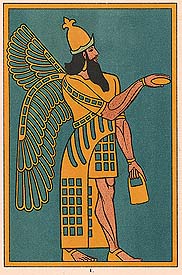
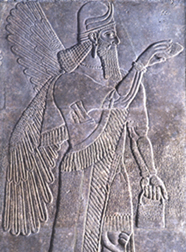
Assyrian Nimrod
The winged genie figures prominently in Assyrian art. It is thought to represent a priest in ritual garb, the king himself, or a "god" who was suppose to keep bad luck away. This winged genie is holding a cone in his right hand and a bucket in his left. These are objects associated with purification and the power to protect. This stone relief was excavated from the site of a grand palace at Nimrud (modern day Iraq) and was part of a freize consisting of more than four hundred separate carvings that decorated the passageway to the throne room of the king.
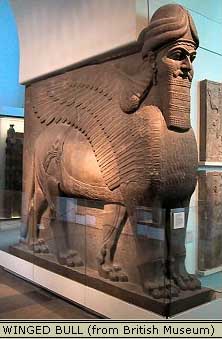
Human Headed Winged Bull - Neo-Assyrian Period
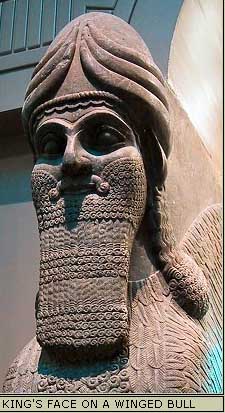
This colossal sculpture was one of a pair that guarded the entrance to the throne room of King Sargon II. A protective spirit known as a "lamassu", it is shown as a composite being with the head of a human, the body and ears of a bull, and the wings of a bird. When viewed from the side, the creature appears to be walking; when viewed from the front, to be standing still. Thus it is actually represented with five, rather than four, legs.

Glazed Brick Representing a Half Fish Half Bird Man
The city-state of Ashur had extensive contact with cities on the Anatolian plateau. The Assyrians established "merchant colonies" in Cappadocia, e.g., at Kanesh (modern Kultepe) circa 1920 -1840 BC and 1798 -1740 BC. These colonies, called 'Karum', the Akkadian word for 'port', were attached to Anatolian cities, but physically separate, and had special tax status. Trade consisted of metal - lead and tin and textiles that were traded for precious metals in Anatolia.
The city of Ashur was conquered by Shamshi-Adad I (1813-1791 BC) in the expansion of Amorite tribes from the Khabur delta. He put his son Ishme-Dagan on the throne of nearby Ekallatum, and allowed trade to continue. Only after the death of Shamshi-Adad and the fall of his sons, did Hammurabi of Babylon conquer Ashur.
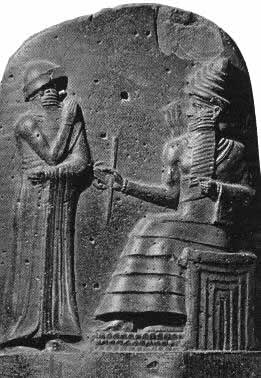
Hammurabi
With Hammurabi, the various karum in Anatolia ceased trade activity, probably because the goods of Assyria were now being traded with the Babylonians' partners.
In the 15th century BC, Saushtatar, king of "Hanilgalbat" (Hurrians of Mitanni), sacked Ashur and made Assyria a vassal. Assyria paid tribute to Hanilgalbat until Mitanni power collapsed from Hittite pressure, enabling Ashur-uballit I (1365 BC1330 BC), to again make Assyria an independent and conquering power.
Hanilgalbat was finally conquered under Adad-nirari I, who described himself as a "Great-King" (Sharru rabu) in letters to the Hittite rulers.
Adad-nirari I's successor, Shalmaneser I, made Calah his capital, and followed up on expansion to the northwest, mainly at the expense of the Hittites, reaching as far as Carchemish.
His son and successor, Tukulti-Ninurta, deposed Kadashman-Buriash of Babylon and ruled there himself, as king for seven years. Following this, Babylon revolted against Tukulti-Ninurta, and later even made Assyria tributary during the reigns of the Babylonian kings Melishipak II and Marduk-apal-iddin I, another weak period for Assyria.
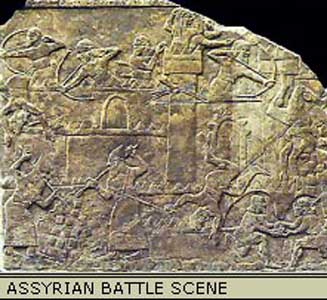

Assyrian Officials
The Assyrian state was forged in the crucible of war, invasion, and conquest. The upper, land-holding classes consisted almost entirely of military commanders who grew wealthy from the spoils taken in war. The army was the largest standing army ever seen in the Middle East or Mediterranean. The exigencies of war excited technological innovation which made the Assyrians almost unbeatable: iron swords, lances, metal armor, and battering rams made them a fearsome foe in battle.
As the Hittite empire collapsed from onslaught of the Phrygians (called Mushki in Assyrian annals), Babylon and Assyria began to vie for Amorite regions, formerly under firm Hittite control. The Assyrian king Ashur-resh-ishi defeated Nebuchadnezzar I of Babylon in a battle, when their forces encountered one another in this region.
In 1120 BC, Ashur-resh-ishi's son, Tiglath-Pileser I crossed the Euphrates, capturing Carchemish, defeated the Mushki and the remnants of the Hittites - even claiming to reach the Black Sea - and advanced to the Mediterranean, subjecting Phoenicia. He also marched into Babylon twice, assuming the old title "King of Sumer and Akkad", although he was unable to depose the actual Babylonian king on these occasions. He may be regarded as the founder of the first Assyrian empire.
After Tiglath-Pileser I, the Assyrians were in decline for nearly two centuries, a time of weak and ineffective rulers, wars with neighboring Urartu, and encroachments by Aramaean nomads. This long period of weakness ended with the accession in 911 BC of Adad-nirari II. He brought the areas still nominally under Assyrian vassalage firmly under subjection, deporting populations in the north to far-off places. Apart from pushing the boundary with Babylonia slightly southward, he did not engage in actual expansion, and the borders of the empire he consolidated reached only as far west as the Khabur. He was succeeded by Tukulti-Ninurta II, who made some gains in the north during his short reign.
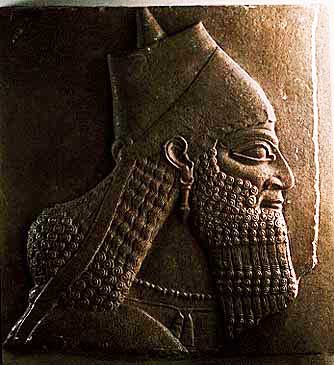
The next king, Ashurnasirpal II (883 BC-858 BC), embarked on a vast program of merciless expansion, first terrorizing the peoples to the north as far as Nairi, then subjecting the Aramaeans between the Khabur and the Euphrates. His harshness prompted a revolt that was crushed decisively in a pitched, two-day battle. Following this victory, he advanced without opposition as far as the Mediterranean and exacted tribute from Phoenicia. Unlike any before, the Assyrians began boasting in their ruthlessness around this time. Ashurnasirpal II also moved his capital to the city of Kalhu (Nimrud).
Ashurnasirpal's son, Shalmaneser III (858 BC-823 BC), fought against Urartu, and in the reign of Ahab, king of Israel, he marched an army against an alliance of the Syrian states (a rare occasion in near-eastern history of an alliance between the Israeli state and the Aramaic Kingdom), whose allied army he encountered at Karkar in (854 BC). Despite Shalmaneser's description of 'vanquishing the opposition', it seems that the battle ended in a deadlock, as the Assyrian forces were withdrawn soon afterwards. Shalmaneser retook Carchemish in 849 BC, and in 841 BC marched an army against Hazael, King of Damascus, besieging and taking that city. He also brought under tribute Jehu of Israel, Tyre, and Sidon. His black obelisk, discovered at Kalhu, records many military exploits of his reign.
In the following century, Assyria again experienced a relative decline, owing to weaker rulers (including the Queen Semiramis) and a resurgence in expansion by Urartu. The notable exception was Adad-nirari III (810 BC-782 BC), who brought Syria under tribute as far south as Edom and advanced against the Medes, perhaps even penetrating to the Caspian Sea.
In 745 BC, the crown was seized by a military adventurer called Pul, who assumed the name of Tiglath-Pileser III. After subjecting Babylon to tribute and severely punishing Urartu, he directed his armies into Syria, which had regained its independence.
He took Arpad near Aleppo in 740 BC after a siege of three years, and reduced Hamath. Azariah (Uzziah) had been an ally of the king of Hamath, and thus was compelled by Tiglath-Pileser to do him homage and pay yearly tribute.In 738 BC, in the reign of Menahem, king of Israel, Tiglath-Pileser III occupied Philistia and invaded Israel, imposing on it a heavy tribute (2 Kings 15:19). Ahaz, king of Judah, engaged in a war against Israel and Syria, appealed for help to this Assyrian king by means of a present of gold and silver (2 Kings 16:8); he accordingly "marched against Damascus, defeated and put Rezin to death, and besieged the city itself."
Leaving part of his army to continue the siege, he advanced, ravaging with fire and sword the province east of the Jordan, Philistia, and Samaria; and in 732 BC took Damascus, deporting its inhabitants to Assyria. In 729 BC, he had himself crowned as "King Pul of Babylon".
Tiglath-Pileser III died in 727 BC, and was succeeded by Shalmaneser V, who reorganized the Empire into provinces, replacing the troublesome vassal kings with Assyrian governors. However, King Hoshea of Israel suspended paying tribute, and allied himself with Egypt against Assyria in 725 BC. This led Shalmaneser to invade Syria (2 Kings 17:5) and besiege Samaria (capital city of Israel) for three years.
Shalmaneser V was deposed in 722 BC in favour of Sargon, the Tartan (commander-in-chief of the army), who then quickly took Samaria, carrying 27,000 people away into captivity into the Israelite Diaspora, and effectively ending the northern Kingdom of Israel. (2 Kings 17:1-6, 24; 18:7, 9).
He also overran Judah, and took Jerusalem (Isa. 10:6, 12, 22, 24, 34). In 721 BC, Babylon threw off the rule of the Assyrians, under the powerful Chaldean prince Merodach-baladan (2 Kings 20:12), and Sargon, unable to contain the revolt, turned his attention again to Syria, Urartu, and the Medes, penetrating the Iranian Plateau as far as Mt. Bikni and building several fortresses, before returning in 710 BC and retaking Babylon.
Sargon also built a new capital at Dur Sharrukin ("Sargon's City") near Nineveh, with all the tribute Assyria had collected from various nations.In 705 BC, Sargon was slain while fighting the Cimmerians, and was succeeded by his son Sennacherib (2 Kings 18:13; 19:37; Isa. 7:17, 18), who moved the capital to Nineveh and made the deported peoples work on improving Nineveh's system of irrigation canals.
In 701 BC, Hezekiah of Judah formed an alliance with Egypt against Assyria, so Sennacherib accordingly marched toward Jerusalem, destroying 46 villages in his path.
This is graphically described in Isaiah 10; exactly what happened next is unclear (the Bible says an Angel of the Lord smote the Assyrian army at Jerusalem; Herodotus says they were destroyed by a plague of field mice at Egypt; modern historians suspect Plague in both instances); however what is certain, is that the besieging army was somehow decimated, and Sennacherib failed to capture Jerusalem.
In 689 BC, Babylonia again revolted, but Sennacherib responded swiftly by opening the canals around Babylon and flooding the outside of the city until it became a swamp, resulting in its destruction, and its inhabitants were scattered. In 681 BC, Sennacherib was murdered, most likely by one of his sons.
Sennacherib was succeeded by his son Esarhaddon (Ashur-aha-iddina), who had been governor of Babylonia under his father. As king, he immediately had Babylon rebuilt, and made it his capital.
Defeating the Cimmerians and Medes (again penetrating to Mt. Bikni), but unable to maintain order in these areas, he turned his attention westward to Phoenicia - now allying itself with Egypt against him - and sacked Sidon in 677 BC.
He also captured Manasseh of Judah and kept him prisoner for some time in Babylon (2 Kings 19:37; Isa. 37:38). Having had enough of Egyptian meddling, he next invaded that country in 674 BC, conquering it all by 670 BC.
Assyria was also at war with Urartu and Dilmun (probably modern Qatar) at this time. This was Assyria's greatest territorial extent.
However, the Assyrian governors Esarhaddon had appointed over Egypt were obliged to flee the restive populace, and while leading another army to pacify them, Esarhaddon died suddenly, in 669 BC.Assur-bani-pal or Ashurbanipal (Ashurbanapli, Asnappar), the son of Esarhaddon, succeeded him.
He continued to campaign in Egypt, when not distracted by pressures from the Medes to the east, and Cimmerians to the north of Assyria.
Unable to contain Egypt, he installed Psammetichus as a vassal king in 663 BC, but by 652 BC, this vassal king was strong enough to declare outright independence from Assyria with impunity, especially as Ashurbanipal's brother, Shamash-shum-ukin, governor of Babylon, began a civil war in that year that lasted until 648 BC, when Babylon was sacked and the brother set fire to the palace, killing himself. Elam was completely devastated in 646 BC and 640 BC.
Ashurbanipal had promoted art and culture, and had a vast library of cuneiform tablets at Nineveh, but upon his death in 627 BC, the Assyrian Empire began to disintegrate rapidly. Babylonia became independent; their king Nabopolassar, along with Cyaxares of Media, destroyed Nineveh in 612 BC, and Assyria fell. A general called Ashur-uballit II, with military support from the Egyptian Pharaoh Necho II, held out as a remnant of Assyrian power at Harran until 609 BC, after which Assyria ceased to exist as an independent nation. However, the Assyrian people have managed to keep their identity, and still exist as a distinct ethnic group, mainly in northern Iraq, where they are distinguished from their Arab, Kurdish, and Turkmen neighbors by their traditions, politics, Christian religion, and Aramaic dialect.




0 comments:
Post a Comment